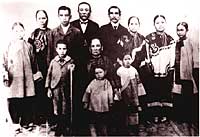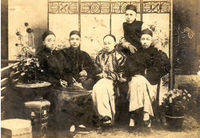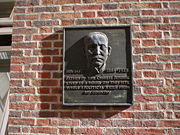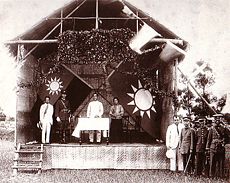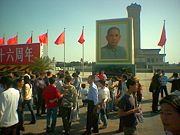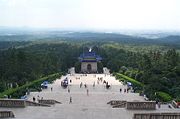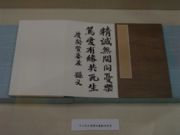Sun Yat-sen
2008/9 Schools Wikipedia Selection. Related subjects: Political People
|
Sun Yat-sen
孫文 孫中山 孫逸仙 |
|
 |
|
|
President of the Republic of China
provisional |
|
|---|---|
| In office 01 January 1912 – 01 April 1912 |
|
| Vice President | Li Yuanhong |
| Preceded by | Office created |
| Succeeded by | Yuan Shikai |
|
|
|
| Born | 12 November 1866 Xiangshan, China |
| Died | 12 March 1925 (aged 58) Beijing, China |
| Nationality | Chinese |
| Political party | Kuomintang |
| Spouse | Lu Muzhen (1885 – 1915) Soong Ching-ling (1915 – 1925) |
| Alma mater | Hong Kong College of Medicine for Chinese |
| Occupation | Physician Politician Revolutionary Writer |
| Religion | Congregationalist |
Sun Yat-sen ( Traditional Chinese: 孫逸仙; simplified Chinese: 孙逸仙; Pinyin: Sūn Yìxiān) or Sun Zhongshan ( Traditional Chinese: 孫中山; simplified Chinese: 孙中山; Pinyin: Sūn Zhōngshān) ( November 12, 1866 – March 12, 1925) was a Chinese revolutionary and political leader often referred to as the Father of Modern China. Sun played an instrumental role in the eventual collapse of the Qing Dynasty in 1911. He was the first provisional president when the Republic of China (ROC) was founded in 1912 and later co-founded the Kuomintang (KMT) where he served as its first leader. Sun was a uniting figure in post-Imperial China, and remains unique among 20th-century Chinese politicians for being widely revered in both Mainland China and in Taiwan.
Although Sun is considered one of the greatest leaders of modern China, his political life was one of constant struggle and frequent exile. After the success of the revolution, he quickly fell out of power in the newly-founded Republic of China, and led successive revolutionary governments as a challenge to the warlords who controlled much of the nation. Sun did not live to see his party bring about consolidation of power over the country. His party, which formed a fragile alliance with the Communists, split into two factions after his death. Sun's chief legacy resides in his developing a political philosophy known as the Three Principles of the People (The People's Relation/Connection, The People's Power, and the People's Livelihood/Welfare, or sometimes known as nationalism, democracy, and socialism depending on the translation).
Early years
Sun Yat-sen was born on November 12, 1866, to a peasant family in the village of Cuiheng, Xiangshan county , Guangzhou prefecture, Guangdong province (26 km or 16 miles north of Macau). When Sun Yat-sen died in 1925, the name of Xiangshan was changed to Zhongshan in his honour.When Sun Yat-sen was a child, he listened many stories about Taiping Rebellion from Taiping old soldier the Lai han-ing(賴漢英). After receiving a few years of local school, at age thirteen, Sun went to live with his elder brother, Sun Mei, in Honolulu. Sun Mei, who was fifteen years Sun Yat-sen's senior, had emigrated to Hawaii as a laborer and had become a prosperous merchant. Though Sun Mei was not always supportive of Sun's later revolutionary activities, he supported his brother financially, allowing Sun to give up his professional career. Sun Yat-sen studied at the prestigious Iolani School where he learned English, mathematics and science. Originally unable to speak the English language, Sun Yat-sen picked up the language so quickly that he received a prize for outstanding achievement in English from King David Kalakaua. He became a citizen of the United States and was issued an American passport. It is unclear whether or not he maintained his original citizenship as a subject of the Qing empire. After graduation from Iolani School in 1882, Sun enrolled in Oahu College (now Punahou School) for further studies for one semester.. He was soon sent home to China as his brother was becoming afraid that Sun Yat-sen was about to embrace Christianity. While at Iolani, he befriended Tong Phong, who later founded the First Chinese-American Bank.
His American experience was to be of lasting influence. Sun attached particular importance to the ideas of Alexander Hamilton and Abraham Lincoln. Sun often said that the formulation of Lincoln's Gettysburg Address, “government of the people, by the people, for the people”, had been the inspiration for the Three Principles of the People. He incorporated these ideas, later in life, in two highly influential books. One, The Vital Problem of China (1917), analyzed some of the problems of colonialism: Sun warned that “…the British treat nations as the silkworm farmer treats his worms; as long as they produce silk, he cares for them well; when they stop, he feeds them to the fish.” The second book, International Development of China (1921), presented detailed proposals for the development of infrastructure in China, and attacked the ideology of laissez-faire, as well as that of Marxism adhering more to the ideas of Henry George's, particularly land value taxation. His ideology remained flexible, however, reflecting his audience as much as his personal convictions. He presented himself as a strident nationalist to the nationalists, as a socialist to the socialists, and an anarchist to the anarchists, declaring at one point that “the goal of the Three Principles of the People is to create socialism and anarchism.” It is an open matter of debate whether this eclecticism reflected a sincere effort to incorporate ideas from the multiple competing schools of thought or was simply opportunistic posturing. In any case, his ideological flexibility allowed him to become a key figure in the Nationalist movement since he was one of very few people who had good relations with all of the movement's factions.
When he returned home in 1883, he became greatly troubled by what he saw as a backward China that demanded exorbitant taxes and levies from its people. The schools maintained their ancient methods, leaving no opportunity for expression of thought or opinion. Under the influence of Christian missionaries in Hawaii, Sun had developed a disdain for traditional Chinese religious beliefs. One day, Sun and his childhood friend Lu Hao-tung passed by Beijidian(北極殿), a temple in Cuiheng Village, where they saw many villagers worshipping the Beiji (literally North Pole) Emperor-God in the temple. They broke off the hand of the statue, incurring the wrath of fellow villagers, and escaped to Hong Kong.
Sun studied English at the Anglican Diocesan Home and Orphanage (currently Diocesan Boys' School) in Hong Kong. In April 1884, Sun was transferred to the Central School of Hong Kong (later renamed Queen's College). Sun was later baptized in Hong Kong by an American missionary of the Congregational Church of the United States, to his brother's disdain. Sun pictured a revolution as similar to the salvation mission of the Christian church. His conversion to Christianity was related to his revolutionary ideals and push for advancement. As a result, his baptismal name, Rixin (日新), literally means "daily renewal."
| Sun Yat-sen |
|
| Names ( details) | |
|---|---|
| Known in English as: | Sun Yat-sen |
| Chinese: | 孫逸仙 |
| Hanyu Pinyin: | Sūn Yìxiān |
| Wade-Giles: | Sun I-hsien |
| Cantonese: | Sun Yat-sen |
| Hokkien POJ: | Sun Ek-sian |
| Known to Chinese as: | 孫中山 |
| Hanyu Pinyin: | Sūn Zhōngshān |
| Wade-Giles: | Sun Chung-shan |
| Hokkien POJ: | Sun Tiong-soan |
| Family name: | Sun |
| Traditional Chinese: | 孫 |
| Simplified Chinese: | 孙 |
| Given | names |
| Register name : | Démíng (德明) |
| Milk name : | Dìxiàng (帝象) |
| School name : | Wén (文) |
| Courtesy name : | Zaizhi (載之) |
| Pseudonym : | Rìxīn (日新), later |
| Yìxiān (逸仙), | |
| pronounced similarly in Cantonese (Yat San, Yat Sin, resp.) |
|
| Alias : | Zhōngshān (中山) |
| Alias in Japan: | Nakayama Shō (中山樵) |
| Styled: | Gúofù (國父), i.e. |
| “ Father of the Nation” | |
Sun studied medicine at the Guangzhou Boji Hospital under the medical missionary John G. Kerr. Ultimately, he earned the license of medical practice as a medical doctor from the Hong Kong College of Medicine for Chinese (the forerunner of The University of Hong Kong) in 1892, of which he was one of the first two graduates. He subsequently practiced medicine in that city briefly in 1893. He had an arranged marriage with fellow villager Lu Muzhen at age twenty; she bore him a son Sun Fo, who would grow up to become a high ranking official in the Republican government, and two daughters, Sun Yan and Sun Wan.
During and after the Qing Dynasty rebellion, Sun was a leader within Tiandihui, a precursor to modern triad groups. Tiandihui provided much of Sun's funding. His protégé, Chiang Kai Shek, was also a member of Tiandihui .
Transformation into a revolutionary
Sun, who had grown increasingly troubled by the conservative Qing government and its refusal to adopt knowledge from the more technologically advanced Western nations, quit his medical practice in order to devote his time to transforming China. At first, Sun aligned himself with the reformists Kang Youwei and Liang Qichao who sought to transform China into a Western-style constitutional monarchy. In 1894, Sun wrote a long letter to Li Hongzhang, the governor-general of Zhili and a reformer in the court, with suggestions on how to strengthen China, but he was rebuffed. Since Sun had never been trained in the classics, the gentry did not accept Sun into their circles. From then on, Sun began to call for the abolition of the monarchy and the establishment of a republic.
Sun went to Hawaii in October 1894 and founded the Revive China Society to unveil the goal of a prospering China and as the platform for future revolutionary activities. Members were drawn mainly from fellow Cantonese expatriates and from the lower social classes.
From exile to Wuchang Uprising
In 1895 a coup he plotted failed, and for the next sixteen years Sun was an exile in Europe, the United States, Canada, and Japan, raising money for his revolutionary party and bankrolling uprisings in China. In Japan, where he was known as Nakayama Shō ( Kanji: 中山樵, lit. The Woodcutter of Middle Mountain), he joined dissident Chinese groups (which later became the Tongmenghui) and soon became their leader. He spent, on and off, about ten years in Japan while befriending and being financially aided by a democratic revolutionary in Japan, Miyazaki Toten (1871-1922). Nanjing Historical Remains Museum of Chinese Modern History exhibits a bronze statue of Sun and Miyazaki placed alongside. Miyazaki wrote a series of articles for newspapers including nationally-circulated Asahi about Sun and his revolutionary efforts under the title "33-year dream". His last name Nakayama came from the imperial family which occupied Sun's favorite estate mansion located in central Tokyo. He eventually left Japan due to fears of the excessively large level of support he had there and went to the States. In Japan, He met and befriended Mariano Ponce, then a diplomat of the First Philippine Republic. Sun also supported the cause for Philippine Independence and even supplied the Philippine army with guns. On October 10, 1911, a military uprising at Wuchang in which Sun had no direct involvement (at that moment Sun was still in exile and Huang Xing was in charge of the revolution), began a process that ended over two thousand years of imperial rule in China. When he learned of the successful rebellion against the Qing emperor from press reports, Sun immediately returned to China from the United States. Later, on December 29, 1911 a meeting of representatives from provinces in Nanking elected Sun as the provisional President of the Republic of China and set January 1, 1912 as the first day of the First Year of the Republic. This republic calendar system is still used in Taiwan today.
The official history of the Kuomintang (and for that matter, the Communist Party of China) emphasizes Sun's role as the first provisional President, but many historians now question the importance of Sun's role in the 1911 revolution and point out that he had no direct role in the Wuchang uprising and was in fact out of the country at the time. In this interpretation, his naming as the first provisional President was precisely because he was a respected but rather unimportant figure and therefore served as an ideal compromise candidate between the revolutionaries and the conservative gentry.
However, Sun is credited for the funding of the revolutions and for keeping the spirit of revolution alive, even after a series of failed uprisings. Also, as mentioned, he successfully merged minor revolutionary groups to a single larger party, providing a better base for all those who shared the same ideals.
Sun is highly regarded as the National Father of modern China. His political philosophy, known as the Three Principles of the People, was proclaimed in August 1905. In his Methods and Strategies of Establishing the Country completed in 1919, he suggested using his Principles to establish ultimate peace, freedom, and equality in the country. He devoted all efforts throughout his whole lifetime until his death for a strong and prosperous China and the well being of its people.
Republic of China
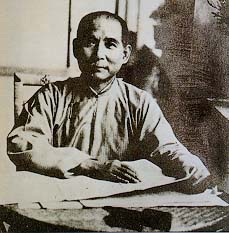
After taking the oath of office, Sun Yat-sen sent telegrams to the leaders of all provinces, requesting them to elect and send new senators to establish the National Assembly of the Republic of China. The Assembly then declared the provisional government organizational guidelines and the provisional law of the Republic as the basic law of the nation.
The provisional government was in a very weak position. The southern provinces of China had declared independence from the Qing dynasty, but most of the northern provinces had not. Moreover, the provisional government did not have military forces of its own, and its control over elements of the New Army that had mutinied was limited, and there were still significant forces which had not declared against the Qing.
The major issue before the provisional government was gaining the support of Yuan Shikai, the man in charge of the Beiyang Army, the military of northern China. After Sun promised Yuan the presidency of the new Republic, Yuan sided with the revolution and forced the emperor to abdicate. (Eventually, Yuan proclaimed himself emperor and afterwards opposition snowballed against Yuan's dictatorial methods, leading him to renounce the throne shortly before his death in 1916.) In 1913 Sun led an unsuccessful revolt against Yuan, and he was forced to seek asylum in Japan, where he reorganized the Kuomintang. He married Soong Ching-ling, one of the Soong sisters, in Japan on October 25, 1915, without divorcing his first wife Lu Muzhen due to opposition from the Chinese community. Lu pleaded with him to take Soong as a concubine but this was also unacceptable to Sun's Christian ethics.
Guangzhou militarist government
In the late 1910s, China was greatly divided by different military leaders without a proper central government. Sun saw the danger of this, and returned to China in 1917 to advocate unification. He started a self-proclaimed military government in Guangzhou (Canton), Guangdong Province, southern China, in 1921, and was elected as president and generalissimo.
In a February 1923 speech presented to the Students' Union in Hong Kong University, he declared that it was the corruption of China and the peace, order and good government of Hong Kong that turned him into a revolutionary. This same year, he delivered a speech in which he proclaimed his Three Principles of the People as the foundation of the country and the Five-Yuan Constitution as the guideline for the political system and bureaucracy. Part of the speech was made into the National Anthem of the Republic of China.
To develop the military power needed for the Northern Expedition against the militarists at Beijing, he established the Whampoa Military Academy near Guangzhou, with Chiang Kai-shek as its commandant and with such party leaders as Wang Ching-wei and Hu Han-min as political instructors. The Academy was the most eminent military school of the Republic of China and trained graduates who fought in the Second Sino-Japanese War and on both sides of the Chinese Civil War.
However, as soon as he established his government in Guangzhou, Sun Yat-sen came into conflict with entrenched local power. Sun's militarist government was not based on the Provisional Constitution of 1912, which the anti-Beiyang forces vowed to defend in the Constitutional Protection War. In addition, Sun was elected president by a parliament that did not meet quorum following its move from Beijing. Thus, many politicians and warlords alike challenged the legitimacy of Sun's militarist government. Sun's use of heavy taxes to fund the Northern Expedition to militarily unify China also came at odds with reformers such as Chen Jiongming, who advocated establishing Guangdong as a “model province” before launching a costly military campaign. In sum, Sun's military government was opposed by the internationally-recognized Beiyang government in the north, Chen's Guangdong provincial government in the south, and other provincial powers that shifted alliance according to their own benefit.
Path to Northern Expedition and death
He again became premier of the Kuomintang from 10 October 1919 – 12 March 1925. In the early 1920s Sun received help from the Comintern for his reorganization of the Kuomintang as a Leninist Democratic-Centrist Party and negotiated the First CCP-KMT United Front. In 1924, in order to hasten the conquest of China, he began a policy of active cooperation with the Chinese Communists.
By this time, Sun was convinced that the only hope for a unified China lay in a military conquest from his base in the south, followed by a period of political tutelage that would culminate in the transition to democracy. Sun then prepared for the later Northern Expedition with help from foreign powers until his death.
On November 10, 1924, Sun traveled north and delivered another speech to suggest gathering a conference for the Chinese people and the abolition of all unequal treaties with the Western powers. Two days later, he yet again traveled to Peking (Beijing) to discuss the future of the country, despite his deteriorating health and the ongoing civil war of the warlords. Although ill at the time, he was still head of the southern government. On November 28, 1924 Sun traveled to Japan and gave a remarkable speech on Pan-Asianism at Kobe, Japan. He left Guangzhou to hold peace talks with the northern regional leaders on the unification of China. Sun died of liver cancer on March 12, 1925, at the age of 58 at the Rockefeller Hospital in Beijing.
Legacy
One of Sun's major legacies was his political philosophy, the Three Principles of the People (sanmin zhuyi, 三民主義). These Principles included the principle of nationalism (minzu, 民族), democracy (minquan, 民權) and the People's Livelihood (minsheng, 民生). The Principles retained a place in the rhetoric of both the Kuomintang and the Chinese Communist Party with completely different interpretations. This difference in interpretation is due partly to the fact that Sun seemed to hold an ambiguous attitude to both capitalist and communist methods of development, as well as due to his untimely death, in 1925, before he had finished his now-famous lecture series on the Three Principles of the People. In addition, Sun is also one of the primary saints of the Vietnamese religion Cao Dai.
Power struggle
After Sun's death, a power struggle between his young protégé Chiang Kai-shek and his old revolutionary comrade Wang Jingwei split the KMT. At stake in this struggle was the right to lay claim to Sun's ambiguous legacy. In 1927 Chiang Kai-shek married Soong May-ling, a sister of Sun's widow Soong Ching-ling, and subsequently he could claim to be a brother-in-law of Sun. When the Communists and the Kuomintang split in 1927, marking the start of the Chinese Civil War, each group claimed to be his true heirs, a conflict that continued through World War II.
The official veneration of Sun's memory, especially in the Kuomintang, was a virtual cult, which centered around his tomb in Nanking. His widow, Soong Ching-ling, sided with the Communists during the Chinese Civil War and served from 1949 to 1981 as Vice President (or Vice Chairwoman) of the People's Republic of China and as Honorary President shortly before her death in 1981.
Father of the Nation
Sun Yat-sen remains unique among twentieth-century Chinese leaders for having a high reputation both in mainland China and in Taiwan. In Taiwan, he is seen as the Father of the Republic of China, and is known by the posthumous name Father of the Nation, Mr. Sun Chungshan (Chinese: 國父 孫中山先生, where the one-character space is a traditional homage symbol). His likeness is still almost always found in ceremonial locations such as in front of legislatures and classrooms of public schools, from elementary to senior high school, and he continues to appear in new coinage and currency.
Forerunner of the Revolution
On the mainland, Sun is also seen as a Chinese nationalist and proto-socialist, and is highly regarded as the Forerunner of the Revolution. He is mentioned by name in the preamble to the Constitution of the People's Republic of China. In most major Chinese cities one of the main streets is named "Zhongshan" (中山) to memorialize him, a name even more commonly found than other popular choices such as "Renmin Lu" (人民路), or The People's Road, and "Jiefang Lu" (解放路), or Liberation Road. There are also numerous parks, schools, and geographical features named after him. The city of Zhongshan in Guangdong, where Sun was originally from, is named after Sun, and there is a hall dedicated to his memory at the Temple of Azure Clouds in Beijing.
In recent years, the leadership of the Communist Party of China has been increasingly invoking Sun, partly as a way of bolstering Chinese nationalism in light of Chinese economic reform and partly to increase connections with supporters of the Kuomintang on Taiwan which the PRC sees as allies against Taiwanese independence. Sun's tomb was one of the first stops made by the leaders of both the Kuomintang and the People First Party on their trips to mainland China in 2005. A massive portrait of Sun continues to appear in Tiananmen Square for May Day and the National Day.
Sun and the overseas Chinese
Sun's notability and popularity extends beyond the Greater China region, particularly to Nanyang where a large concentration of overseas Chinese reside in Singapore and Malaysia. Sun recognised the contributions that the large number of overseas Chinese could make, beyond the sending of remittances to their ancestral homeland. He therefore made multiple visits to spread his revolutionary message to these communities around the world.
Sun made a total of eight visits to Singapore between 1900 and 1911. His first visit made on September 7, 1900, was to rescue Miyazaki Toten, an ardent Japanese supporter and friend of Sun's, who was arrested there, an act which also resulted in his own arrest and a ban from visiting the island for five years. Upon his next visit in June 1905, he met local Chinese merchants Teo Eng Hock, Tan Chor Nam and Lim Nee Soon in a meeting which was to mark the commencement of direct support from the Nanyang Chinese. Upon hearing their reports on overseas Chinese revolutionists organising themselves in Europe and Japan, he urged them to establish the Singapore chapter of the Tongmenghui, which came officially into being on 6 April the following year upon his next visit.
The chapter was housed in a villa known as Wan Qing Yuan (晚晴園) and donated for the use of revolutionalists by Teo. In 1906, the chapter grew in membership to 400, and in 1908, when Sun was in Singapore to escape the Qing government in the wake of the failed Zhennanguan Uprising, the chapter had become the regional headquarters for Tongmenghui branches in Southeast Asia. Sun and his followers travelled from Singapore to Malaya and Indonesia to spread their revolutionary message, by which time the alliance already had over twenty branches with over 3,000 members around the world.
Sun's foresight in tapping on the help and resources of the overseas Chinese population was to bear fruit on his subsequent revolutionary efforts. In one particular instance, his personal plea for financial aid at the Penang Conference held on November 13, 1910 in Malaya, helped launch a major drive for donations across the Malay Peninsula, an effort which helped finance the Second Guangzhou Uprising (also commonly known as the Yellow Flower Mound revolt) in 1911.
The role that overseas Chinese in Southeast Asia played during the 1911 Revolution was so significant that Sun himself recognized "Overseas Chinese as the Mother of the Revolution".
Today, Sun's legacy is remembered in Nanyang at Wan Qing Yuan, which has since been preserved and renamed as the Sun Yat Sen Nanyang Memorial Hall, and gazetted as a national monument of Singapore on October 28, 1994.
In Penang, the Penang Philomatic Union which was founded by Sun in 1908, has embarked on a heritage project to turn its premises at 65 Macalister Road into Dr. Sun Yat-Sen Museum. The project is expected to complete in late 2006.
